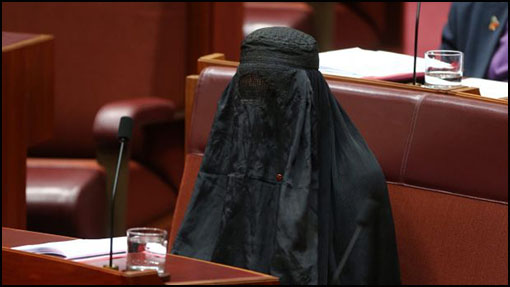851 Burqa anyone?
So, is
the burqa just a fashion item? Of course not, and an article in the SMH says most emphatically, no: Pauline
Hanson's Senate stunt shows why we need to confront the ideology behind the
burqa, by Elham Manea

SMH photo: Andrew Meares
In
Australia anyone can wear what s/he wants to wear ... in private or indeed in public, and I have no objection to that. But myself, I am not comfortable to be confronted by anybody who hides his/her face
from me, for whatever reason.
I have written about this before - blog 386:
Once a man walked into my gallery, and like most people who visited me, he made eye contact, smiled and gestured in a way to let me know he was ‘just having a look’, not intent on buying anything. That’s fine with me ... I smiled back, “if you have any questions, just let me know.” We acknowledged one another in a pleasant, though uncommitted manner. Then I noticed two more persons, who were with him.
Right behind him was his son, he was about ten years old. When I looked at him, he just smiled at me and started inspecting my pictures.
But a few meters behind these two males was a female. She hesitantly entered the gallery and remained close to the entrance, with just a cursory glance at my art works. She wore a total body-covering garment - a Niqab - with just her eyes (hardly) visible … not that I got to look at her eyes. She made not even the most fleeting contact with me. I felt most uncomfortable in her presence; I was glad when the three left my shop.
I believe the face is a person's most important feature when it comes to interacting with other people. Facial expressions are consequential in communications; often a facial expression is as important - if not even more so - than the spoken word. This issue of course is most pertinent for a photographer who likes to photograph people ... one is inclined to concentrate on the face.
For me
the security issue brought up by Hanson is secondary, if not
spurious. That of course is just a superficial personal opinion. In
her article E. Manea goes deeper:
Pauline
Hanson wearing a burqa in Parliament was a political stunt. We know that. It
was not meant as a defence for women's rights. Obviously. You do not have to
like her politics or her party. Put your aversion aside and focus on the issue
she was raising.
The burqa
(niqab in Arabic) is a symbol. When you see it in a community, it indicates
that an ideology and a radical form of Islam are spreading. In my field
research on women and sharia law in Britain, South Africa and Middle Eastern
countries, I heard this sentence a lot: "Ten years ago, we only had few
women with the burqa. Today there are plenty."
Let's just
get something straight: the burqa is not Islamic. It is a custom imported from
Najd, a region in Saudi Arabia and the power base of its Salafi fundamentalist
form of Islam. Within Muslim countries it is very contested and considered
fringe. Even conservative Mufti of Al Azhar - the highest religious authority
in Sunni Islam - said in a 2010 TV program that the burqa is a
"custom" not a "religious requirement".
1979 witnessed the Iranian
Islamic revolution, the occupation of radical Salafis of the holy Kabaa in
Mecca, and the Soviet invasion of Afghanistan. The three events led to an
active Saudi policy, enforcing the dogmas of its politicised fundamentalism in
its own borders and spreading it worldwide. Religion was a tool to fight
communism and to claim leadership of the Islamic world. But it was not any
religion that was promoted. It was a fringe fundamentalist interpretation of
Islam.
Women
according to this world view, are a source of evil that should be covered from
head to toe to protect the men from seduction. They are perpetual minors,
obedient to their male guardians. Husbands have the right to discipline their
wives by beating.
In Muslim
majority countries, this type of Islam has led to persecution of minorities - think of the persecution of Christians and Ahmadyyias in Indonesia. In Western
societies it leads to the segregation of Muslim minorities in closed societies.
It paves the ground actively for the recruitment of disoriented youth to
violence. So when you see women in burqa, think of the ideology that is
mainstreaming it. We should confront it - Muslims and non-Muslims alike.
A final
note; it helps to think of this issue from the perspective of the tradition
that produced it. In Saudi Arabia, Afghanistan, and IS-controlled areas women
are forced to wear it. Why do you think Saudi women activists have launched
this year a campaign with the hash tag the niqab (burqa) does not represent me?
They are rejecting this oppression and fighting for their freedom. I am sure
many of them are wondering why on earth some Australian politicians are
defending "Muslim women's right to wear the burqa". Think of
enslavement as synonymous to burqa, and their marvel will become clear.
Dr Elham
Manea is an Islamic scholar in the department of political science at the
University of Zurich, Switzerland, a former Swiss government commissioner and
author of Women and Sharia Law.